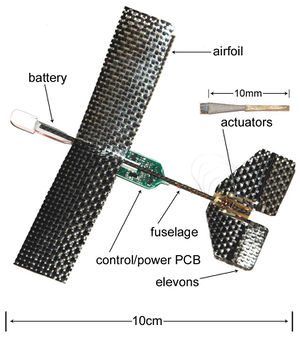Difference between revisions of "Media"
Jump to navigation
Jump to search
m |
|||
| Line 76: | Line 76: | ||
*: Paper describing the meteorological campaigns on Iceland and Spitsbergen. Also available from the [http://www.iop.org/EJ/abstract/1755-1315/1/1/012014 IOP conference site]</small> | *: Paper describing the meteorological campaigns on Iceland and Spitsbergen. Also available from the [http://www.iop.org/EJ/abstract/1755-1315/1/1/012014 IOP conference site]</small> | ||
* [http:// | * [http://download.paparazziuav.org/papers/papers_2008/ENAC_MAV08.pdf YAP - Yet Another Paparazzi]<br><small>(4M, PDF) - March 2008 | ||
*: Technical paper of the ENAC entry at [http://www.nal.res.in/MAV08 MAV08]</small> | *: Technical paper of the ENAC entry at [http://www.nal.res.in/MAV08 MAV08]</small> | ||
* [http:// | * [http://download.paparazziuav.org/papers/papers_2007/easyDrone.pdf "easyDrone - La nouvelle interface de pilotage de drone (french)"]<br><small>(8.1M, PDF) - March 2007 | ||
*:This report describres a proposal for a new kind of GCS, highly dynamic (no more static flight plan) and using modern interactions (gesture recognition, ...)</small> | *:This report describres a proposal for a new kind of GCS, highly dynamic (no more static flight plan) and using modern interactions (gesture recognition, ...)</small> | ||
* [http:// | * [http://download.paparazziuav.org/papers/papers_2006/mav06_paparazzi.pdf "The Paparazzi Solution"]-[http://download.paparazziuav.org/papers/papers_2006/mav06_paparazzi_slides.pdf (slides)]<small><br>(4.6MB pdf) - September 2006 | ||
*:This paper describes the Paparazzi project approach: The complete and integrated design of hardware, software, and airframe into a robust and reliable system, proven by formal analytical methods and thousands of flight hours. | *:This paper describes the Paparazzi project approach: The complete and integrated design of hardware, software, and airframe into a robust and reliable system, proven by formal analytical methods and thousands of flight hours. | ||
*:Best Oral / Technical Presentation - MAV-06 | *:Best Oral / Technical Presentation - MAV-06 | ||
*:''Brisset, Drouin, Gorraz, Huard, Tyler''</small> | *:''Brisset, Drouin, Gorraz, Huard, Tyler''</small> | ||
* [http:// | * [http://download.paparazziuav.org/papers/papers_2005/jpo_2005.pdf "Présentation JPO" (French)]<small><br>(8MB pdf) - October 2005 | ||
*:A brief presentation of Paparazzi@Enac | *:A brief presentation of Paparazzi@Enac | ||
*:''Drouin, Brisset''</small> | *:''Drouin, Brisset''</small> | ||
| Line 95: | Line 95: | ||
*:''Doscot, Mansouri, Poupard''</small> | *:''Doscot, Mansouri, Poupard''</small> | ||
* [http:// | * [http://download.paparazziuav.org/papers/papers_2004/drones_et_micro_drones.pdf "Drones et micro-drones" (French)]<small><br>(10.5MB pdf) - 2004 | ||
*:Introduction to UAVs; presentation of the Paparazzi project | *:Introduction to UAVs; presentation of the Paparazzi project | ||
*:''Drouin, Brisset''</small> | *:''Drouin, Brisset''</small> | ||
| Line 103: | Line 103: | ||
*:''Drouin, Brisset''</small> | *:''Drouin, Brisset''</small> | ||
* [http:// | * [http://download.paparazziuav.org/papers/papers_2004/rapport_a_matthieu.pdf "Traitement de la video" (French)]<small><br>(2.7MB pdf) - 2004 | ||
*:Video data processing | *:Video data processing | ||
*:''Matthieu Tobie''</small> | *:''Matthieu Tobie''</small> | ||
Latest revision as of 09:37, 8 January 2014
Also see the Wall of Records and Papers page.
Paparazzi in the News
|
Design Reports
Manuals
|
Other Sites of Interest
- "Design, Fabrication and Initial Results of a 2g Autonomous Glider"
(900K, PDF) - July 2007- Utilizing the core technologies of emerging microrobotic structures, the rapid design and prototyping of a passive micro air vehicle with the final goal of locating an audio source while avoiding hazardous obstacles is presented. The airfoil and control surfaces are optimized empirically to maximize lift and maneuverability while minimizing drag. Bimorph piezoelectric bending cantilevers actuate the control surfaces. Since such actuators require high voltages, an efficient boost circuit is presented along with appropriate high voltage electronics. To locate audio sources, a pair of acoustic sensors is designed and prototyped using a phase detection algorithm while a custom optic flow sensor is developed to avoid obstacles and give estimates of object distances and velocities. Finally, each subsystem is demonstrated and the complete glider is integrated to demonstrate initial open loop control performance.
